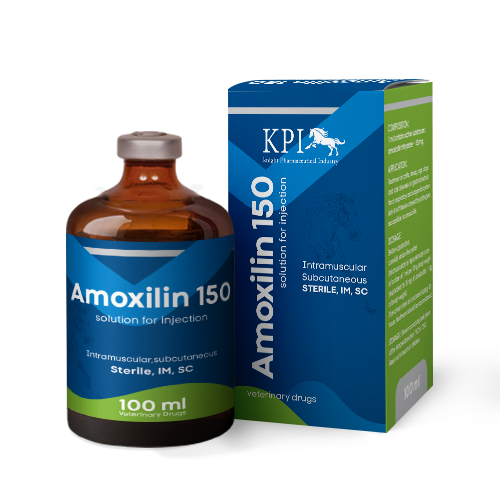
COMPOSITION:
1 ml contains:
Amoxicillin trihydrate – 150 mg.
CLINICAL PHARMACOLOGY:
Amoxicillin is a broad-spectrum antibiotic belonging to the amoxicillin group. It works by disrupting the synthesis of bacterial cell walls, inhibiting enzymes such as transpeptidase and carboxypeptidase. This disruption leads to an osmotic imbalance and ultimately causes the death of bacteria in their growth phase. Amoxicillin is effective against a wide range of bacteria, both gram-positive and gram-negative, including Actinomyces spp., Bacillus anthracis, Clostridium spp., Corynebacterium spp., Listeria monocytogenes, Staphylococcus spp., Streptococcus spp., Actinobacillus spp., Escherichia coli, Fusobacterium spp., Haemophilus spp., Moraxella spp., Pasteurella spp., Salmonella spp., and Leptospira spp.
APPLICATION:
Amoxicillin is indicated for the treatment of diseases in cattle, sheep, pigs, dogs, and cats affecting the gastrointestinal tract, respiratory system, urogenital system, as well as skin and soft tissues. These diseases are caused by pathogens that are susceptible to amoxicillin.
DOSAGE:
Before application, it’s important to shake the bottle carefully. Administer intramuscularly or hypodermically once at a dose of 1 ml per 10 kg body weight (equivalent to 15 mg of amoxicillin per 1 kg of body weight).
If recovery does not occur within 48 hours, treatment should be re-evaluated. Use only dry sterile needles and syringes for administration. When doses exceed 20 ml for cattle, 10 ml for pigs, or 5 ml for sheep and goats, it’s necessary to divide the dosage and administer it in different injection sites.
CONTRAINDICATIONS:
Warnings:
- Avoid use in animals with hypersensitivity to amoxicillin. Do not administer to horses, rabbits, guinea pigs, hamsters, and other small herbivores.
- Do not inject intravenously.
- Use with caution in weak, emaciated, and animals with severe renal insufficiency.
- Avoid simultaneous administration with sulfonamides and antibiotics such as cephalosporin, tetracycline, and macrolides.
WITHDRAWAL:
- Consumption of meat from treated animals is allowed 14 days after the last application of the drug.
- Consumption of milk is allowed 48 hours after the last application of the drug.
Meat and milk obtained within these withdrawal periods should either be utilized or fed to unproductive animals, as determined by a veterinarian.
PACKAGING:
Glass flasks 100 ml.
STORAGE :
Opened flask is usable for 14 days, storing at a dry, dark place at a temperature from 5ºC to 15ºC.
FOR VETERINARY USE ONLY!
